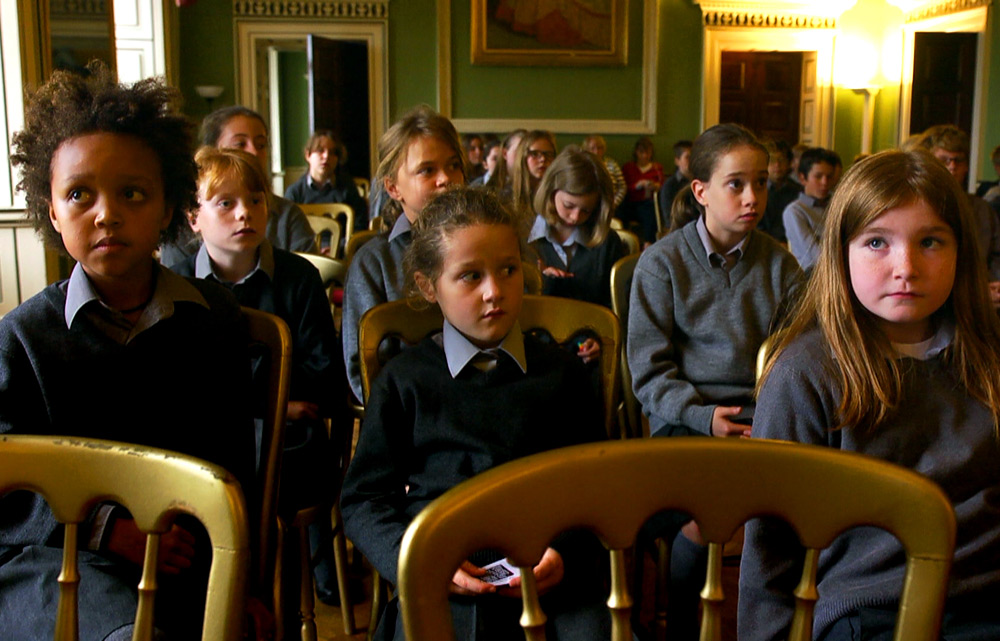Like most at Headfort, a boarding school in County Kells, Ireland, the first day of the fall semester brought jitters to Neasa Ni Chianain and David Rane, but for entirely different reasons than the students or the teachers.
“There’s all these new characters coming,” said Ni Chianain. “You have no idea who’s going to be your main character and from the very beginning, [we said] we weren’t going to select the children that were going to be main characters, [but] not knowing who to follow was very difficult … you’re finding your feet and you’ve radio mic’d all these different people and it’s mad.”
Says Rane, “It was one of the only occasions where we brought in a second crew on the first day of school and [then] the last day because there was so much going on. And we didn’t use it in the end.”
As it turns out what the married filmmakers found in the middle was more than enough, generally operating as just a two-person crew to intimately capture the inner workings of a school an hour outside of Dublin for roughly a hundred kids ranging from 3 to 13 that is steeped in tradition but not many rules. Dermot Dix, the headmaster, uses a student orientation to declare that “It’s up to you as much as your teachers” about what they can get out of their education, and he should know having been educated at Headfort himself decades earlier by John and Amanda Leyden, the school’s music and English teachers, respectively, who nurture conversation as opposed to assigning work for their students. Only at Headfort can innocent dialogues can grow out of whether gay couples should have the right to get married and evolve into talks about the existence of God, and kids build their confidence by seizing the mic to sing The Undertones’ “Teenage Kicks” in a backroom hideaway where John Leyden holds court.
Yet even after doing it all these years and dressing the part, clad in shaggy battle fatigues hat hearken back to their own youth during the ‘60s, the Leydens are the ones who aren’t entirely sold on their methodology, questioning themselves throughout the semester about whether their work is effective, matching the energy of their young pupils in the demands they place on themselves to serve the students well. Drawing on the freneticism of the unorthodox boarding school setting, “School Life” feels largely unmediated as it chronicles a year in the life, and as the film hits American shores after premiering earlier this year at Sundance (under the title “In Loco Parentis”), Ni Chianain and Rane spoke about embedding themselves in such an extraordinary environment to capture their subjects so intimately, balancing work and their personal lives when it was all intertwined at Headfort and convincing the school to let their cameras in.
Neasa Ni Chianain: It started as a hunt for a school for our own children, really. We were living in a very idyllic, rural part of Ireland on the North Atlantic coast and the children were attending a small little Irish speaking school with four teachers. We thought, “This is great,” but we realized over time it was actually quite a homogenous community and that we really wanted them to have more of a diverse education. So we started to look in the area, but in rural Ireland, there’s very little choice, so we had to cast the net wider and wider. We looked at Educate Together schools like nondenominational schools, we looked at Steiner Schools and then eventually we found this school [Headfort] on a website and it was the headmaster’s letter that attracted us firstly because he talked about the happiness of the child being at the core of the education. We thought that was a really good starting point.
David Rane: But that’s how we found the school. The decision to make the film came more from the fact that Neasa and I had both been to boarding schools and Neasa had a quite idyllic boarding school experience. She really enjoyed it. I had an awful one. My parents worked in Nigeria and I was sent back to boarding school in England when I was only seven, so I was very young and I only saw them once a year on holidays. So we both wanted to understand and explore what a 21st century boarding school would be like – had it changed? Was it still the same? Personally, I expected to find children who were quite upset about being separated from their parents, but they didn’t, which was quite a pleasure to find. They actually enjoyed being there.
Neasa Ni Chianain: School has, on all levels – boarding and J schools, moved on. The emotional well-being of the child is much more a focal point, rather than just the academics, so generally, we can say that the 21st century school is more child-centered.
So how did your film end up coalescing more around John and Amanda Leyden, the married teachers?
Neasa Ni Chianain: In our research process, we spoke to a lot of alumni — to 50-year-olds, 40-year-olds, 30-year-olds — and John and Amanda were the names that kept coming up. And when we first approached the idea of making this film, they had no interest. They thought it was a very bad idea and they didn’t understand why anyone would want to do it. They were afraid it was going to interfere with the children. All those things rang alarm bells for them and it was through the first year of research that they slowly started to get to know us and think, “Well, okay, they’re not so bad” and we were getting to know the school through our own children and through seeing the effects that this different education had on them.
Towards the end of the summer term, [John and Amanda] invited us to come down to their house for tea and there we were able to talk about what the school meant to us. They spoke about what the school meant to them and then they came back to us about a week later and said, “Look, if you’re going to make this film, we’re in, if you want.” Initially, we filmed with the whole school and all the teachers, but it was those two that attracted us the most because you have to select people that are going to drive the story and they were the two that we admired the most — Amanda with her literature and John with his music, and what they manage to give to the children through those two mediums we found quite extraordinary.

David Rane: It was actually a three-year process. We were [there] a year laying the foundation, meeting the parents, the teachers, the pupils and at the same time, from the production end, trying to attract funding for the film, which was very difficult. Then we actually filmed for two full years, but we edited the film from the second year of the footage, for a lot of reasons, but mostly chronology. The children changed from year to year and much as we would’ve loved to include stories from both years, it would’ve gotten confusing for an audience. But we used a lot of that first year of footage to help us raise the money to make the film.
Neasa Ni Chianain: Yeah, it was only when they actually saw [John and Amanda] that people believed in the project. We had very detailed treatments, but people didn’t believe in the project at all until they saw it.
How’d you actually embed yourself in the school and logistically figure out how to film this?
David Rane: That was a challenge. It’s a huge building, and there were not too many people, but at the same time, we were running up and down stairs and we were moving from the classrooms, which were up at the top of the school and the canteen, where they had their lunch and dinners, was at the bottom. The school gave us a room really to keep our equipment and to retreat to, to decide what to do next as much as we could.
The great thing about having the first year of footage was that we actually knew the rituals of the school and schools don’t change too much. Pupils change, a few teachers change, but the routines and rituals remain the same, so we knew pretty much how the school operated and in the second year, we had a pretty good idea that these things would happen at these times and that was helpful.
Neasa Ni Chianain: Yeah, and you had a better, clearer idea of how to film it because there’s always an expectation of what you’re expected to film, but then what you really want to film is something that people don’t expect you to film. Like say the Shakespeare play – the expectation would be that you’d be in front of stage filming the actual final performance, but that’s not what it’s about. The action is always behind the stage. The reason we had a room [at the school] was it was important for us to be accepted by the children as part of the furniture, so there was no, “Oh look, they’re filming today.” The film crew were in every day and there was nothing that disturbed their day.
There’s a great moment with the headmaster Dermot where he’s talking about his rebellious period in school – or lack thereof, which doesn’t seem like your usual coffee talk, with John and Amanda. Is that the kind of moment you might be referring to as well?
Neasa Ni Chianain: Yeah, well, that was again…
David Rane: Dermot lives on the estate a couple hundred yards from the school. John and Amanda live also in the [same] woods, a little bit further from Dermot, and you get this from the film, but John and Amanda taught Dermot — he was there [at Headfort] as a seven-year-old.
Neasa Ni Chianain: So he has this very deep connection. And the reason he started talking about his rebellion was that stories go around when you’re a headmaster. John told that story about him leading the rebellion of the choir to one of the students and Dermot was [frustrated], going like… “That story’s going around again” [because] all the students were asking him, “Tell us about the rebellion, sir. Didn’t you lead a rebellion?” So that’s how that came up in conversation.

Neasa Ni Chianain: That was a big problem for us. We wanted everybody to know this is a world, because the headmaster lives on the ground, the Leydens live on the grounds, the science teacher also lives on the ground, and how do we do that? We had many drives in the car with John and Amanda up and down that lane, but how are you ever going to know that this isn’t just a country road? In the end, we shot that drone shot towards the end of the year.
David Rane: It was the only thing we shot out of sequence.
Neasa Ni Chianain: We didn’t have the money for it in the beginning anyway. [laughs[ But we needed that link and it was the only way to do it was just to do that drone shot.
Since I read the two of you met when Neasa applied to be an art director on a narrative short David was directing, how did your interests turn towards documentary?
David Rane: I was already produced and directed a couple documentaries when I met Neasa. But I was doing a short fiction film and Neasa was an art director on that and we fell in love. Part of that process was, “Let’s try and work together and we worked together on “No Man’s Land,” another longterm documentary that wasn’t 100% observational, but it had quite a lot of observational material in it. We traveled the country of Ireland, this is before we had children, filming the asylum-seeking process — refugees who came to Ireland seeking political asylum — and we were very immersed in that. We went right into the places where people were living and met them and looked at their living conditions and the challenges they faced. [looking at Neasa] I think you kind of fell in love with the process, as much as falling in love with me. [laughs]
Neasa Ni Chianain: Yeah, I did. I love research anyway and I remember [David] took me to IDFA, the big doc festival [in Amsterdam], and I met all of these people who had this fire in their belly and they had a story they wanted to tell. I was swept away by the excitement of that and it resonated with me because in the art department, it’s great and it’s fun and it’s fantasy, but there was just something very authentic and real about the documentary world. At the same time, I had never studied film, but I went and I did this amazing course in Ireland run by Sé Merry Doyle, this editor [who] brought a load of documentary makers like D.A. Pennebakbr and Kim Longinotto from all over the world to this hotel in the middle of nowhere. There were all these other filmmakers and they all had different voices and it was the observational voice that really blew me away. I always aspired from then on to make observational films. Not all of them have been, but a lot of them have.

Neasa Ni Chianain: Yeah, the next film we made after “No Man’s Land” was “Frank Ned and Busy Lizzie,” which just me and a camera and this 70-year-old bachelor farmer. So that was the beginning, yeah.
As parents, it seems brilliant to figure out how to shoot a film not far from your kids, but does that then become an intense experience when all your time is spent at the same place?
Neasa Ni Chianain: We always tend to do that. [laughs] I’m really afraid that’s kind of the way we live, really.
David Rane: Yeah, but this one much more than anything because our kids were there and they’re in the film — a very small part, but they’re in the film. We’re parents in the school, we’re filmmakers in the school. We’re a couple. We’re not two individuals going back to our separate private lives. It was total immersion, but it was an absolutely wonderful experience. It was such a pleasure to be in that world – to be given the privilege of going into that world for two years. You don’t know how much as filmmakers it means to be given that privilege, to spend time in that kind of world and it was a giant leap of faith by the school board and the headmaster to allow two filmmakers almost complete access. We were really given amazing access.
“School Life” opens on September 8th in New York at the IFC Center and September 15th in Los Angeles at the Monica Film Center and Washington DC at the West End Cinema. A full list of cities and dates is here.





